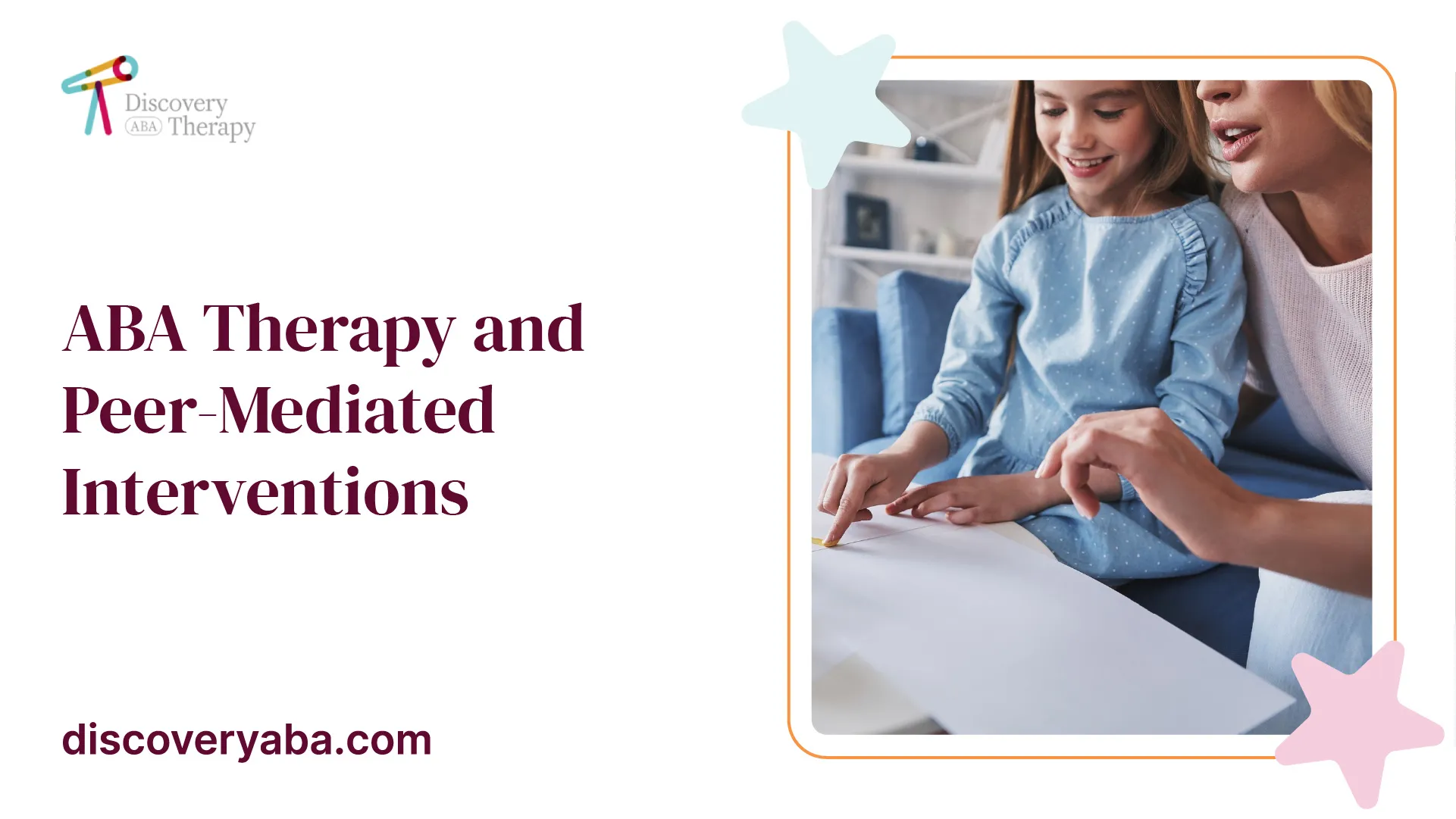ABA Therapy and Peer-Mediated Interventions
Explore ABA therapy and peer-mediated interventions to enhance social skills and support for children with autism.

Understanding ABA Therapy
Introduction to ABA Therapy
ABA therapy, or Applied Behavior Analysis therapy, has been utilized to assist children with autism and related developmental disorders since the 1960s. It is a comprehensive and evidence-based approach that focuses on understanding and modifying behavioral patterns to enhance the lives of individuals with autism [1]. This method involves using techniques that are designed to teach and reinforce desirable behaviors while reducing maladaptive ones.

Fundamental to ABA therapy is the application of learning principles to produce meaningful changes in behavior. Therapists work collaboratively with individuals and their families to develop tailored interventions that meet specific needs. As a result, ABA therapy encompasses a variety of strategies and can be implemented in diverse settings.
Benefits of ABA Therapy
The benefits of ABA therapy are well-documented, and numerous studies have demonstrated its effectiveness in improving outcomes for children with autism. Research shows positive results across multiple areas, including intellectual functioning, language development, daily living skills, and social functioning. The U.S. Surgeon General and the American Psychological Association recognize ABA therapy as an evidence-based best practice treatment for autism [1].
The table below summarizes some of the key areas where ABA therapy can lead to significant improvements:
Area of ImprovementDescriptionIntellectual FunctioningEnhanced cognitive abilities and skills necessary for learning.Language DevelopmentImproved communication skills, including speech and understanding language.Daily Living SkillsIncreased ability to perform self-care tasks and manage daily activities.Social FunctioningBetter social skills, enabling more effective interactions with peers and adults.
By providing structured support and consistent reinforcement, ABA therapy can create meaningful change and foster independence in individuals with autism. Additional resources on ABA therapy can be found in articles covering ABA therapy and visual schedules and ABA therapy and social skills groups.
Essential Components
ABA Therapy employs several essential components that help in effectively teaching skills and managing behaviors in individuals with autism. Two fundamental techniques utilized in this therapy are Discrete Trial Training (DTT) and Antecedent-based Interventions (ABI).
Discrete Trial Training (DTT)
Discrete Trial Training (DTT) is a core teaching strategy used in ABA Therapy. This method breaks skills down into smaller, distinct elements, allowing for focused instruction on each individual component. Following a correct response, positive reinforcement is provided to encourage the desired behavior. This structured format makes it easier for children to learn new skills in manageable steps.
The process typically involves three key components:
For parents and caregivers seeking more information, resources on ABA therapy and visual schedules can be helpful, as schedules support structured learning.
Antecedent-based Interventions (ABI)
Antecedent-based Interventions (ABI) focus on modifying the environment to minimize interfering behaviors that can be triggered by specific antecedents. This approach aims to create a learning environment with fewer distractions, enabling the child to concentrate better on tasks.
ABI techniques may include:
By addressing the antecedents of behaviors, ABI can foster a more conducive learning atmosphere for children with autism. For insights on enhancing social interactions, parents can explore ABA therapy and social skills groups.
Overall, both DTT and ABI play crucial roles in shaping effective ABA Therapy, ensuring that children can develop vital skills while experiencing success in their learning environments.
Parent Involvement
Parent involvement is an essential facet of ABA therapy and peer-mediated interventions for children with Autism Spectrum Disorder (ASD). By actively participating in their child's therapy, parents can foster better learning and development outcomes.
Parent-implemented Interventions (PII)
Parent-implemented interventions (PII) focus on training parents to work alongside ABA practitioners. This collaboration enables parents to provide necessary interventions in their child's natural environments, such as home or community settings. Such approaches have proven effective in ABA programs, as they help in reducing delays in professional care and making interventions more consistent [2].
Implementing these techniques allows parents to reinforce the skills their children are learning during therapy sessions. By rewarding positive behaviors and discouraging negative ones—similar to operant conditioning—they can effectively contribute to their child's growth in social skills, communication, and academic achievement.
Impact of Parent Collaboration
Collaboration between parents and ABA practitioners significantly enhances the effectiveness of therapy. When parents utilize the principles of ABA in everyday situations, they can create a consistent learning environment that supports their child’s progress. The following table illustrates the positive impacts of parent involvement in ABA therapy:
Impact of Parent InvolvementDescriptionIncreased ConsistencyParents can apply learned strategies at home, reinforcing skills.Enhanced Learning OpportunitiesChildren benefit from natural learning opportunities in various settings.Improved CommunicationRegular interaction with ABA practitioners fosters better dialogue about the child's needs.Greater EngagementParents feel more invested in their child's therapy, promoting motivation and persistence.
Parent involvement plays a critical role in maximizing the benefits of ABA therapy. For more information about how parents can support their child's development, check out our articles on aba therapy and parent coaching and aba therapy and community inclusion. By working collaboratively, parents can create a more effective support system that helps their children thrive.
Effectiveness of ABA Therapy
The effectiveness of ABA therapy has been supported by extensive research, demonstrating positive long-term outcomes for children with autism. This section will delve into the long-term impacts of ABA therapy and highlight notable case studies and success stories.
Long-Term Outcomes
Numerous studies have established that intensive and long-term ABA therapy significantly improves various domains for children with autism. According to the US Surgeon General and the American Psychological Association, ABA therapy is recognized as an evidence-based best practice treatment for autism.
A pivotal study revealed that children who received 40 hours of therapeutic intervention per week often achieved average cognitive functioning, highlighting the potential of comprehensive ABA programs to positively transform developmental trajectories.
Area of ImprovementPercentage of Children Showing GainsIntellectual Functioning> 50%Language Development> 60%Social Functioning> 65%Daily Living Skills> 40%
Research findings indicate that ABA principles, when applied over extended periods, lead to significant advancements in communication skills, social skills, and daily living skills for children with Autism Spectrum Disorder (ASD). Furthermore, a meta-analysis of 14 randomized control trials involving 555 participants found promising outcomes in socialization and communication. Many interventions based on ABA have shown to be particularly effective in enhancing expressive language [3].
Case Studies and Success Stories
Success stories often illustrate the profound impact ABA therapy has had on children with autism and their families. One case study involved a young boy diagnosed with ASD who started intensive ABA therapy at the age of three. Within a year, he made substantial progress in communication and social skills. His ability to engage with peers improved, leading to better relationships at school and in recreational settings.
Another compelling case involved a girl who initially struggled with daily living skills. After consistent ABA intervention, she gained autonomy in self-care tasks and developed essential social skills, which contributed to a more independent and fulfilling life. These stories are just a few examples showcasing the transformative power of ABA therapy for individuals with autism.
ABA therapy also pairs effectively with peer-mediated interventions, fostering an inclusive environment that enhances social skills and communication among peers. By focusing on individual learning needs and providing structured support, ABA has been instrumental in the educational success of many children.
The data and anecdotes shared illustrate the effectiveness of ABA therapy in promoting long-term positive outcomes. For additional insights into how ABA can be integrated into educational settings, readers can explore our articles on aba therapy and inclusive education and aba therapy and community inclusion.
Peer-Mediated Interventions
Role of Typically Developing Peers
Typically developing peers play a crucial role in peer-mediated interventions (PMIs) aimed at supporting children with Autism Spectrum Disorder (ASD). By acting as social models, these peers create a positive and enriching environment conducive to learning and growth. In PMIs, typically developing peers are carefully selected based on criteria such as appropriate social skills, social status, and experience in interacting with children with ASD. Teachers often nominate these peers for their qualities, ensuring they can effectively engage and interact with children on the spectrum.
The involvement of typically developing peers helps to enhance various social competencies in children with ASD, including:
Social SkillImpact of PMIsSocial Network InclusionIncreased opportunities for social interactionNon-Verbal Social SkillsEnhanced ability to communicate without wordsPlay SkillsImproved engagement in play activitiesReciprocal Social-Communication SkillsStrengthened two-way communicationFriendshipsGreater likelihood of forming friendships
Studies indicate that the introduction of peers into the ABA therapy framework significantly improves social skills and fosters friendships among children with ASD, enhancing both their social networks and overall social competence [1].
Social Skills Enhancements
The primary focus of utilizing PMIs is to bolster the social skills of children with ASD. Research has consistently shown that interventions involving typically developing peers lead to improvements in several key areas:
Recent studies have explored the impact of PMIs in diverse settings. A study conducted in Shanghai highlighted that PMIs are effective in increasing social motivation for children with mild to moderate ASD, showcasing the intervention's adaptability and effectiveness across varying contexts [5].
The successful execution of PMIs relies significantly on the structured training of peer models. These students are taught specific strategies designed to engage children with ASD, including how to respond effectively and model appropriate social behaviors. By fostering these collaborative environments, PMIs represent a powerful tool in the realm of ABA therapy, promoting not just skill enhancement but also greater inclusion in social settings. For further information on the role of ABA therapy in skill development, check our links on aba therapy and social skills groups and aba therapy and community inclusion.
Research Findings
Exploring the research findings related to ABA therapy and peer-mediated interventions provides insight into their effectiveness for children with Autism Spectrum Disorder (ASD). Various studies have highlighted the benefits of these approaches.
Studies Supporting ABA Therapy
Numerous studies have demonstrated the effectiveness of Applied Behavior Analysis (ABA) therapy in improving outcomes for children with autism through intensive and long-term therapy. Research has shown positive results in several areas including intellectual functioning, language development, daily living skills, and social functioning. The US Surgeon General and the American Psychological Association deem ABA therapy as an evidence-based best practice treatment for autism.
A summary of relevant findings is presented below:
Study FocusFindingsGeneral OutcomesOver 20 studies establish long-term benefits from intensive ABA therapy. Children receiving 40 weekly hours were more likely to achieve average cognitive functioning.Skills DevelopmentABA interventions effectively teach communication, social interaction, and self-help skills, leading to significant improvements in intelligence and language development since the mid-1980s [3].Comparative EffectivenessSubgroup analyses have shown differences in effectiveness among ABA, ESDM, and PECS interventions for general symptoms of ASD, with ESDM showing stronger effects.
Efficacy of PMIs for Children with ASD
Peer-mediated interventions (PMIs) utilize typically developing peers to support children with ASD in developing social and communication skills. Research indicates that such interventions can significantly enhance social interaction and friendships for children on the autism spectrum. By involving peers in activities, these interventions create natural learning opportunities that are crucial for the social functioning of children with ASD.
Evidence of effectiveness includes:
Studies affirm that the integration of peers in therapeutic settings adds a rich layer of social learning, making PMIs a valuable component of comprehensive autism therapy approaches. To explore additional aspects of ABA therapy, check our resources on ABA therapy and social skills groups and ABA therapy for adolescents with autism.
Does Your Child Have An Autism Diagnosis?
Learn More About How ABA Therapy Can Help
Find More Articles
Contact us
North Carolina, Nevada, Utah, Virginia
New Hampshire, Maine
Arizona, Colorado, Georgia, New Mexico, Oklahoma, Texas
.avif)




































































































